The ASUS ZenFone 2 Review
by Brandon Chester on May 26, 2015 8:00 AM ESTSystem Performance
To test Intel's Atom Z3580 SoC I've run the phone through our standard suite of benchmarks. These tests range from browser tests that test the speed of the SoC and the browser's Javascript engine, to more native tests like writing text and seeking through videos. Even some tasks that seem simple can be quite demanding on devices where the entire system is limited to a power envelope of around 3W. Luckily, the ZenFone 2 runs Android Lollipop and so it's using Google's new ART runtime for Java based Android applications. However, even ART is limited in what it can do, as AOT compiler optimizations are limited by a need to balance the CPU's limited power with the need to compile apps quick enough that the user isn't stuck waiting long after they are downloaded.
Although it's a bit unfair as it's a tablet, I've included Dell's Venue 8 7000 in these results because it uses the same SoC as the ZenFone 2 and so it makes for an interesting comparison.
As usual, the first tests that I'll be looking at are our browser benchmarks. Sunspider had become such a large optimization target that it's basically gone from our 2015 benchmark suite, which leaves us with Kraken, Octane, and WebXPRT 2013.

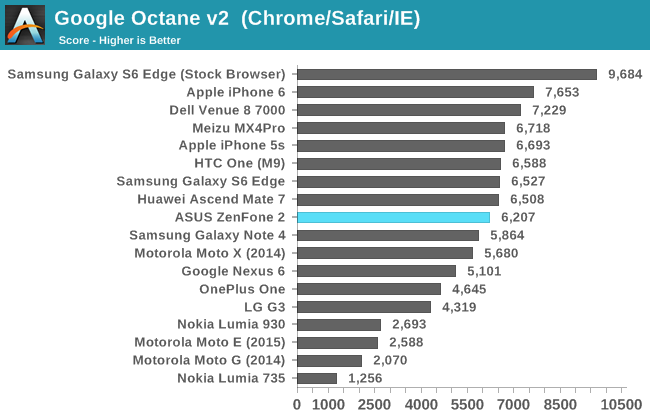
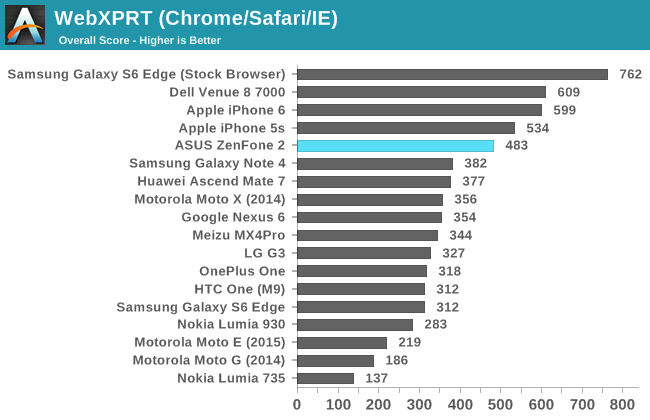
In our web browsing tests the ZenFone 2 performs very well. In the case of Kraken, it does roughly as well as the Venue 8 7000 which uses the same Z3580 SoC. Performance tends to fall behind the Venue 8 in our longer tests like Octane and WebXPRT. I don't have the Venue 8 anymore, but it's a safe bet that this is due to the larger aluminum chassis of the Venue 8 being able to manage heat better in order to keep the clock speeds on the CPU higher during the course of the test.
While the ZenFone 2 isn't quite as fast as a tablet using the same SoC, it's much faster than most of the other devices that we've tested. In general it ends up being a bit slower than the iPhone 5s and the iPhone 6, and of course it loses to the Galaxy S6 using Samsung's browser by an enormous margin in every case. However, a good portion the phones that sit below it are very expensive flagship phones like the Nexus 6, LG G3, and the Galaxy Note 4 which is very impressive for a $300 smartphone.
The next test is Basemark OS II which tests the performance of a device's CPU, GPU, RAM, and NAND.
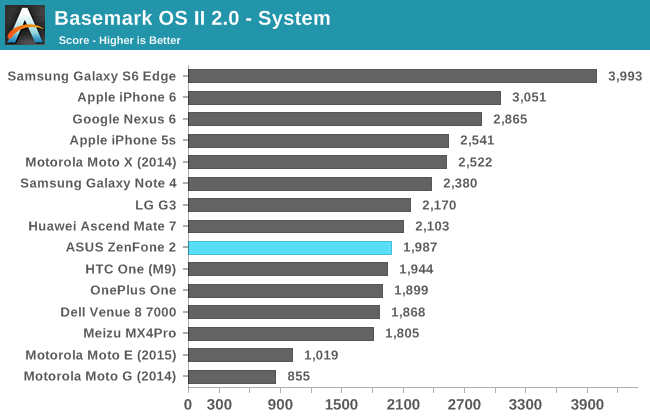
The system sub test performs integer and floating point operations, and also performs some tests like XML parsing. This makes it primarily a test of the device's CPU and RAM. I'm actually somewhat surprised by the ZenFone's performance in this test. By no means is it bad, but I had forgotten that the Venue 8 also struggled to match Snapdragon 801 smartphones in this test.
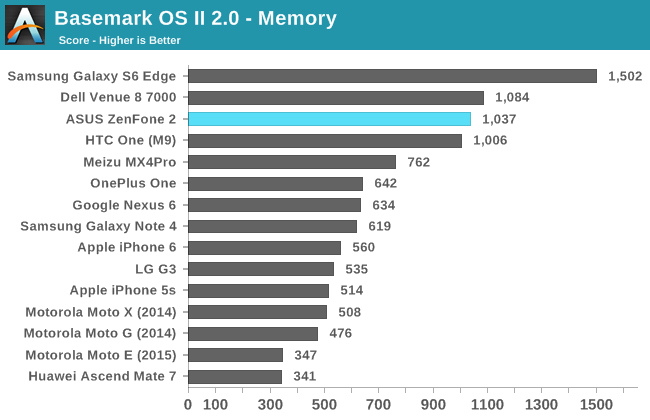
The Basemark OS II memory sub test has a somewhat vague name. While one might expect it to be a test of the device’s RAM, it’s actually a flash storage test. In it we see one of the highest scores of the smartphones we’ve tested, with only the Dell Venue 8 tablet and the Galaxy S6 with its UFS memory achieving higher scores.
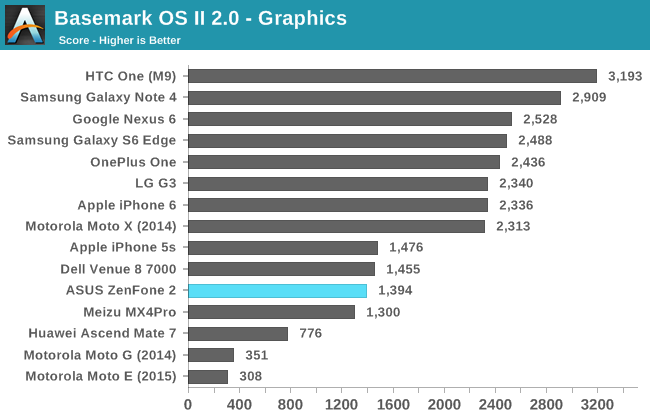
The result in the graphics test is definitely on the lower end of our results, but it’s not unexpected. Both the Venue 8 7000 and the iPhone 5s achieve similar scores, and all three devices use the same G6430 GPU (albeit with lower clock speeds on the iPhone). Even though the ZenFone 2 doesn’t perform as well as the expensive flagship smartphones, it’s far ahead of budget devices like the Moto G. Since both the Z3560 and Z3580 based ZenFone 2 models use the same 533MHz PowerVR G6430 this result should be roughly the same on the $199 model as it is on this $299 model.

The last sub test is the web test. This test focuses on a device’s ability to handle web page rendering, with a focus on HTML5 and CSS rather than Javascript code. In this test we see the ZenFone 2 amongst a large group of devices that includes the HTC One (M9), the Nexus 6, and the Moto X. To see the same level of performance as Snapdragon 805 and 810 devices is very impressive.
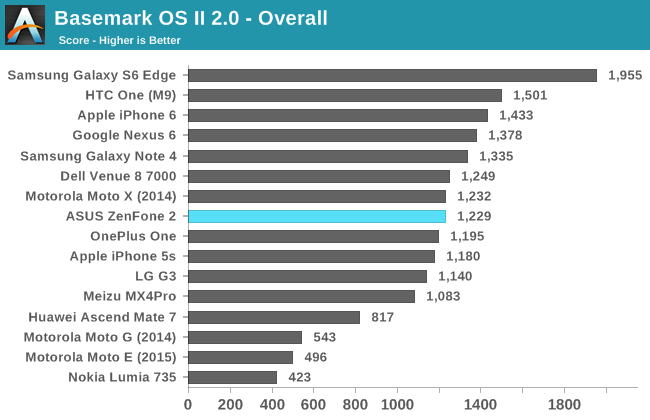
The overall score for BaseMark OS II takes into the account the scores of the various sub tests to generate a final score. In this test we again see the ZenFone 2 around the middle of the pack, with a score that is similar to that of Snapdragon 801 based devices. This is a very good result for a smartphone that costs so little, although the OnePlus One also achieves similar performance at roughly the same price as the $299 model of the ZenFone we are testing.
Our last general performance benchmark is PCMark. This is a relatively new addition to our testing workflow, and it focuses on race to sleep scenarios that reflect the type of usage a device will see in the real world. The tests range from Javascript performance, to playing and seeking in videos, to editing photos.

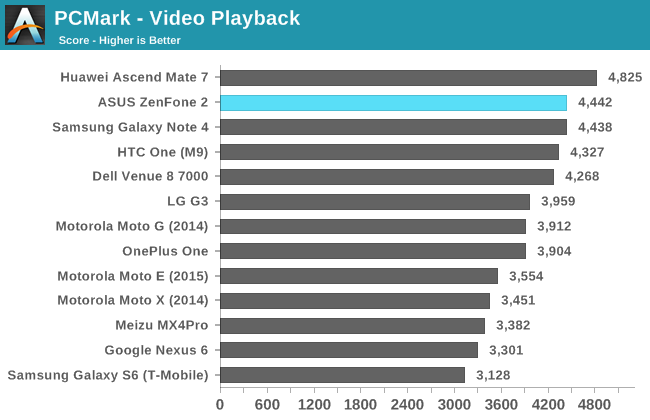
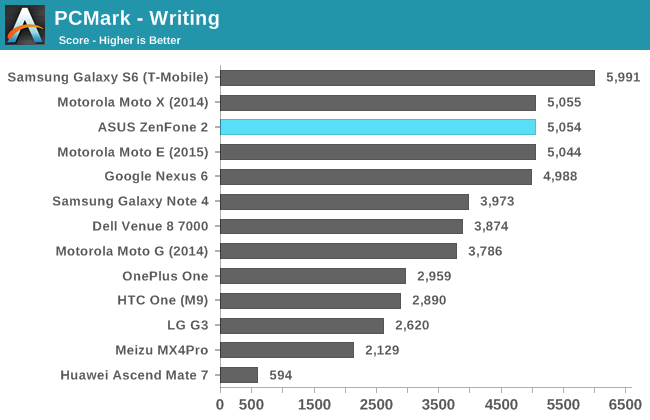
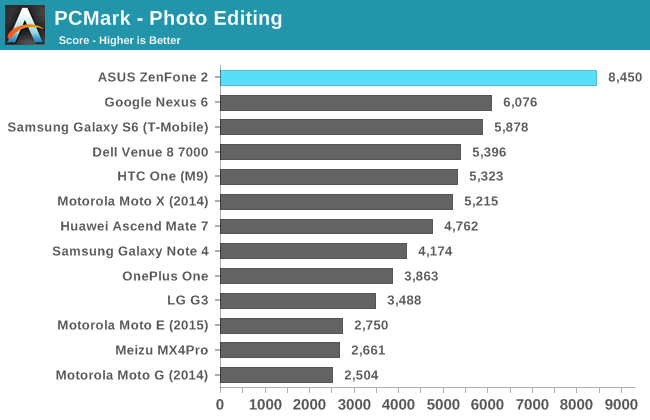
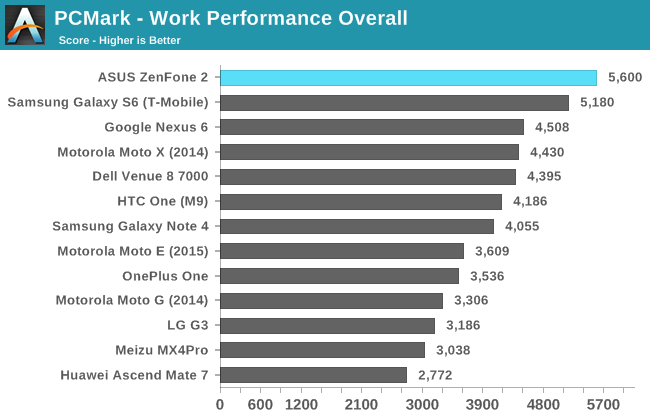
In all of the PCMark sub tests the ZenFone 2 performs extremely well. It’s always at or very close to the top result, and only really loses by a large margin to the Galaxy S6 in the tests that it isn’t right near the top for. The one exception is the photo editing test where it beats every other device by an enormous amount. This score is what carries it to the top position when it comes to the overall score.
I think it’s a bit unfair to say that the ZenFone is the fastest device when it only comes first in a single test, but even without considering the photo editing test it’s clear that the ZenFone 2 offers great performance. Even more amazing is that at times it can trade blows with flagship phones that cost much more than it does. Perhaps due to the fact that it's the only x86 Silvermont-based phone in our benchmarks its relative performance can bounce around versus the competition, but on average it comes rather close to delivering the kind of CPU performance we've seen from the flagship phones over the past year.










147 Comments
View All Comments
lexfury - Thursday, May 28, 2015 - link
It's a shame this isn't the equivalent of $200 in the UK, I would have snapped one up as a replacement for my sadly departed Nexus 5, but the cheapest I could find was £172 from a Chinese website.Not even available from within the UK yet as far as I can see, but will be £200+ no doubt when it arrives.
Still a great bit of kit for the money even at the equivalent of $250 or $300.
Dave* - Sunday, June 7, 2015 - link
Both models are available on Amazon, a U.K. supplier and fulfilled by Amazon (so free next day delivery for Prime customers).Sammaul - Thursday, May 28, 2015 - link
Phone has it's warts, but overall it really seems to be a very good value. And apparently others agree....every color, both versions, are in the top 30 unlocked phones on Amazon US. If Asus continues to update and support this, it could be their ticket into the US market. If they pull a Huawei(with the Mate 2 not getting updates), I will be very disappointed.0iron - Friday, May 29, 2015 - link
"Fast charging is essentially a trade off between battery longevity and charge times, and it really relies on the assumption that smartphones are replaced every two years which is less time than any user would notice possible adverse effects. This rapid replacement of devices is somewhat worrisome, but that's a topic for another time"I really hope the topic about fast charging effect on battery wear will come out sooner rather than later. Reason is I just bought S6 for my wife & our replacement cycle normally in 3-5 years. I foresee to keep S6 for a long time.
I will avoid fast charging now, unless it's really necessary.
cmvrgr - Friday, May 29, 2015 - link
Is it a truly DUAL SIM DUAL ACTIVE ?Rayb - Friday, May 29, 2015 - link
Of the 2 only SIM 1 will do data, SIM 2 is limited to text and calls.cmvrgr - Monday, June 1, 2015 - link
Yes. Is the only officially dsda in the world. I hate that nobody in a review mentioned it. Check their site. And the only with that feature that support band 20 (800) in Europe.nofumble62 - Saturday, May 30, 2015 - link
My Nexus 5 power switch just got stuck last week (phone gone into boot loop), so I got the $200 ASUS as a replacement. I did not miss the Nexus Lollipop at all. The Zenfone2 phone is sweat, at unbelievable price. All my old apps work just fine, and much faster than the Nexus. (I paid $350 for the Nexus5 and thought it was a bargain). I love the double tap to turn on-off. This definitely will eliminate the power button issue like in the Nexus5. I use the power button on the Nexus 5 at least 50 times a day. With the ASUS, may be 2.About bloatwares, it is non-issue. ASUS launcher actually gave me more features than standard Lollipop (such as double tap, shake). The ASUS email apps works great for my hotmail. Previously I used Outlook apps from MS, and it crashed all the time on the Nexus (what's a shame MS).
I tried Google Now launcher, and quickly realized that the double-tap does not work, so I went right back to ASUS launcher.
Anyway, I think this phone got subsidize money from Intel. It won't last forever. Get yours. Heck, at this price, I may pick one up for backup.
cmvrgr - Monday, June 1, 2015 - link
I I haven't decided yet. Super with dsfa , huge ram and good specs.I wonder if the camera is in sony imx 214 quality levels. If someone can confirm that will be super. The only that I hate from Intel cpus is that flash is not running.
I like zenui and runs smoothly in my Asus fonepad 8 dual SIM with 1gb ram only....
Bikram - Monday, June 1, 2015 - link
HI,Yes agreed that Zenfone2 battery discharges fast..... but one factor which is responsible is that it has Dual SIM Dual Active feature... which means that It has 2 receivers always active.... so eats up more power... thats the reason why maximum phones are Dual SIM Dual Standby. which helps in conserving the Battery...
I suggest to rerun these test with Single SIM on all the phones and then compare.....
Either I will be surprised... or Everyone else will be surprised.....
Thanks,